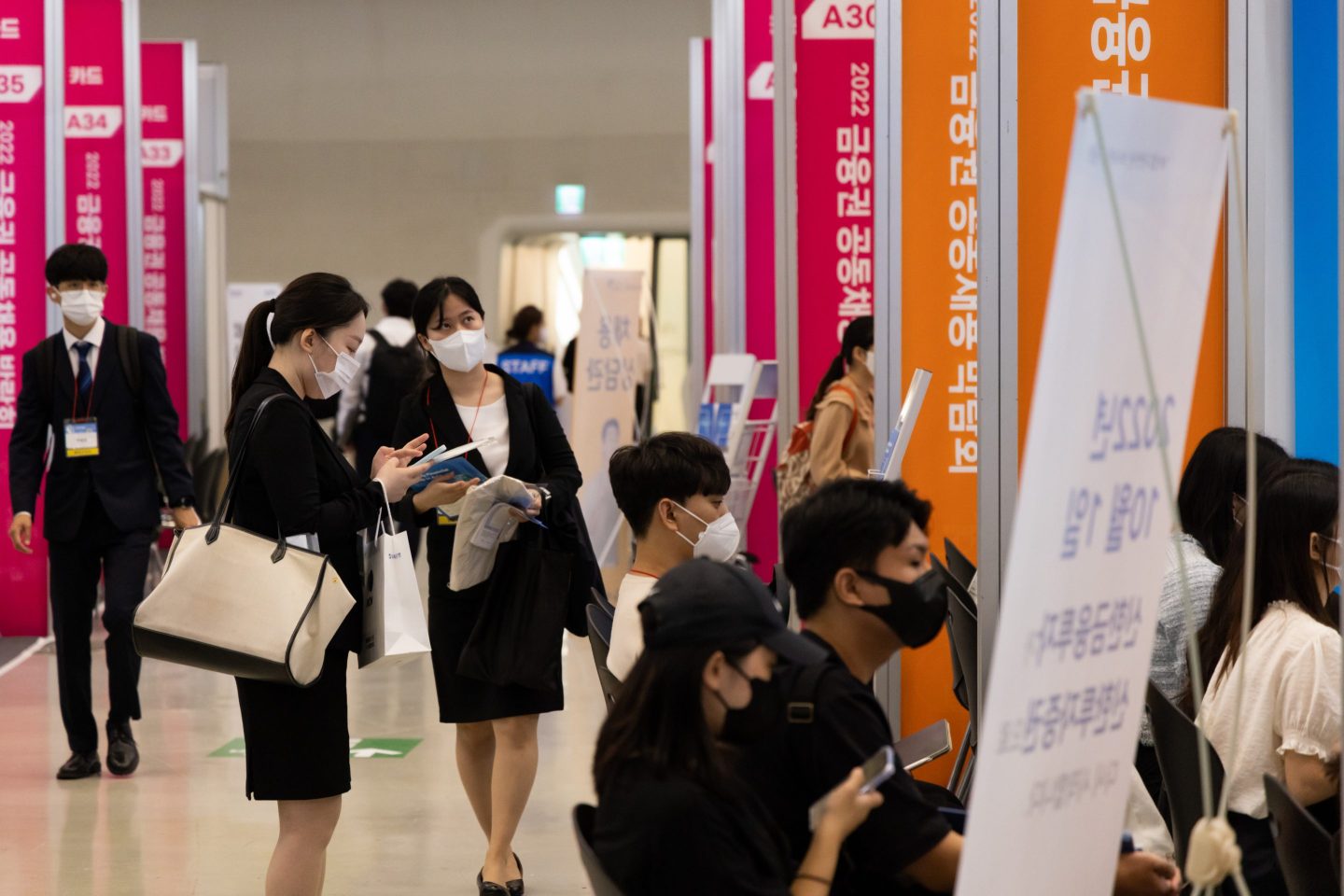
2021年,韩国是世界上生育率最低的国家,其生育率甚至低于2020年,2020年该国生育率排名倒数第一。
韩国统计局表示,2021年,韩国女性一生中平均生育0.81个孩子,连续第六年下降。
韩国人口普查局本周公布的数据显示,同期韩国新生儿数量骤降至26万,创历史新低,较上年同期下降4.3%。这是该国出生人口连续第二年低于30万。
韩国是许多正在经历出生率和生育率下降的发达国家之一。例如,2020年中国香港的生育率为0.9,而新加坡为1.1。
美国的新生儿数量在2021年实际增长了1%,达到360万。
压力源
去年,网飞(Netflix)的韩国系列电视剧《鱿鱼游戏》风靡全球。在节目中,456名负债累累的参赛者在致命游戏中竞争,只为获得赢取4000万美元并消除债务的机会。
该电视剧的主题在世界范围内引起了共鸣,对韩国年轻人来说尤其如此。近年来,他们在韩国社会经济地位上升的机会急剧下降。就业竞争加剧,房价飙升,年轻人转向“快速致富”计划,比如大举借债,投资加密货币和股票,以及在线赌博。
韩国年轻职场人士还面临着巨大的社会压力和工作压力,比如长时间工作以及与老板和同事酗酒。对于职业女性来说,职业压力加剧——韩国超过一半的女性都在工作——她们不仅要把所有事情都做好,还要遵守严格的审美标准和照顾家庭。
这些因素导致年轻人缺乏为人父母的欲望。超过一半的韩国年轻人表示婚后没有必要生孩子。这一情况还加剧了该国的心理健康危机;超过95%的人表示他们有压力,该国的自杀率在所有经合组织国家中最高。
在20世纪70年代,韩国每年的出生人口都徘徊在100万左右。从那以后,这个数字一直在下降。2017年,这一数字首次跌破40万。
去年,该国每千人的出生人数也从2020年的5.3下降到5.1,创历史新低。女性的平均生育年龄也从去年的33.1岁增加到2021年的33.4岁。
“人们结婚、生育和抚养孩子到底有多难才能导致这个数字如此之低?如果我们将此作为衡量基本生活的简要标准,这是一个令人痛苦的数字。”首尔汉阳大学(Hanyang University)政策学教授李三植(Lee Samsik)在接受《纽约时报》采访时表示。
未来发展
2020年,韩国首次出现人口自然减少现象,即死亡人数超过了新生儿人数。据联合国估计,到本世纪末,韩国5100万人口可能会减半。
在过去的几年时间里,韩国一直在努力寻找解决人口和劳动力减少的办法。政府提倡让更多的女性——以及机器人——进入劳动力市场。政府还出台了补贴政策来鼓励家庭多生孩子,包括每生一个孩子就有1185美元的现金奖励,以及在孩子出生后的第一年每月提供224美元的补贴(到2025年将增加到373美元)。工作满六个月的新生儿父母可以享受一年的带薪育儿假。但在实践中,由于职业污名,休陪产假的员工仍然很少,而休产假的母亲往往会因此受到雇主的惩罚。
韩国的低生育率和女性劳动参与率最终“反映出根深蒂固的社会规范,这一社会规范很难扭转。未来几十年劳动力数量急剧下降是不可避免的。”研究公司凯投宏观(Capital Economics)的高级亚洲经济学家加雷思·莱瑟(Gareth Leather)在去年8月的一份报告中写道。
这些补贴“可能在一定程度上有所帮助,但我们怀疑它能产生巨大的影响。对父母的经济支持往往对生育影响很有限。”莱瑟说。
韩国已实施改革,向移民劳工敞开大门。然而,考虑到成为韩国公民面临的挑战,其人口中只有3%是在国外出生的。公众舆论也反对大规模移民进入该国。
如果政府没有采取重大干预措施,该国可能会在未来五年左右出现严重的劳动力短缺;韩国健康与社会事务研究所(Korea Institute for Health and Social Affairs)的人口统计学家李相林(Lee Sang-lim)告诉《纽约时报》,在三到四代人的时间内,韩国人口可能会急剧下降。(财富中文网)
译者:中慧言-王芳
2021年,韩国是世界上生育率最低的国家,其生育率甚至低于2020年,2020年该国生育率排名倒数第一。
韩国统计局表示,2021年,韩国女性一生中平均生育0.81个孩子,连续第六年下降。
韩国人口普查局本周公布的数据显示,同期韩国新生儿数量骤降至26万,创历史新低,较上年同期下降4.3%。这是该国出生人口连续第二年低于30万。
韩国是许多正在经历出生率和生育率下降的发达国家之一。例如,2020年中国香港的生育率为0.9,而新加坡为1.1。
美国的新生儿数量在2021年实际增长了1%,达到360万。
压力源
去年,网飞(Netflix)的韩国系列电视剧《鱿鱼游戏》风靡全球。在节目中,456名负债累累的参赛者在致命游戏中竞争,只为获得赢取4000万美元并消除债务的机会。
该电视剧的主题在世界范围内引起了共鸣,对韩国年轻人来说尤其如此。近年来,他们在韩国社会经济地位上升的机会急剧下降。就业竞争加剧,房价飙升,年轻人转向“快速致富”计划,比如大举借债,投资加密货币和股票,以及在线赌博。
韩国年轻职场人士还面临着巨大的社会压力和工作压力,比如长时间工作以及与老板和同事酗酒。对于职业女性来说,职业压力加剧——韩国超过一半的女性都在工作——她们不仅要把所有事情都做好,还要遵守严格的审美标准和照顾家庭。
这些因素导致年轻人缺乏为人父母的欲望。超过一半的韩国年轻人表示婚后没有必要生孩子。这一情况还加剧了该国的心理健康危机;超过95%的人表示他们有压力,该国的自杀率在所有经合组织国家中最高。
在20世纪70年代,韩国每年的出生人口都徘徊在100万左右。从那以后,这个数字一直在下降。2017年,这一数字首次跌破40万。
去年,该国每千人的出生人数也从2020年的5.3下降到5.1,创历史新低。女性的平均生育年龄也从去年的33.1岁增加到2021年的33.4岁。
“人们结婚、生育和抚养孩子到底有多难才能导致这个数字如此之低?如果我们将此作为衡量基本生活的简要标准,这是一个令人痛苦的数字。”首尔汉阳大学(Hanyang University)政策学教授李三植(Lee Samsik)在接受《纽约时报》采访时表示。
未来发展
2020年,韩国首次出现人口自然减少现象,即死亡人数超过了新生儿人数。据联合国估计,到本世纪末,韩国5100万人口可能会减半。
在过去的几年时间里,韩国一直在努力寻找解决人口和劳动力减少的办法。政府提倡让更多的女性——以及机器人——进入劳动力市场。政府还出台了补贴政策来鼓励家庭多生孩子,包括每生一个孩子就有1185美元的现金奖励,以及在孩子出生后的第一年每月提供224美元的补贴(到2025年将增加到373美元)。工作满六个月的新生儿父母可以享受一年的带薪育儿假。但在实践中,由于职业污名,休陪产假的员工仍然很少,而休产假的母亲往往会因此受到雇主的惩罚。
韩国的低生育率和女性劳动参与率最终“反映出根深蒂固的社会规范,这一社会规范很难扭转。未来几十年劳动力数量急剧下降是不可避免的。”研究公司凯投宏观(Capital Economics)的高级亚洲经济学家加雷思·莱瑟(Gareth Leather)在去年8月的一份报告中写道。
这些补贴“可能在一定程度上有所帮助,但我们怀疑它能产生巨大的影响。对父母的经济支持往往对生育影响很有限。”莱瑟说。
韩国已实施改革,向移民劳工敞开大门。然而,考虑到成为韩国公民面临的挑战,其人口中只有3%是在国外出生的。公众舆论也反对大规模移民进入该国。
如果政府没有采取重大干预措施,该国可能会在未来五年左右出现严重的劳动力短缺;韩国健康与社会事务研究所(Korea Institute for Health and Social Affairs)的人口统计学家李相林(Lee Sang-lim)告诉《纽约时报》,在三到四代人的时间内,韩国人口可能会急剧下降。(财富中文网)
译者:中慧言-王芳
South Koreans are having so few children that their country had the world’s lowest fertility rate in 2021, even lower than the preceding year in which the nation also came in dead last.
South Korean women averaged 0.81 births during their lifetimes in 2021—the sixth straight year of decline, says Statistics Korea.
Over the same period, the number of newborns in the country plunged to a new, all-time low of 260,000, down 4.3% from the year prior, according to South Korea census bureau data released this week. It’s the second consecutive year that the country’s childbirths dipped below 300,000.
South Korean is among many developed nations that are experiencing a decline in childbirths and fertility rates. For example, Hong Kong had a fertility rate of 0.9 in 2020 while Singapore’s was at 1.1.
In the U.S., the number of newborns actually rose 1% in 2021 to 3.6 million.
Stressors
Last year, South Korean Netflix series Squid Game took the world by storm. In the show, 456 indebted contestants compete in deadly games for a chance to win $40 million and erase their debts.
Its themes resonated worldwide, but particularly for young South Koreans, whose chances at moving up the country’s socioeconomic ladder have plummeted in recent years. Job competition has intensified, home prices have skyrocketed, and young people have turned to ‘get rich quick’ schemes like bingeing on debt to invest in cryptocurrencies and stocks, along with online gambling.
Young Korean professionals also face significant societal pressures to conform, and work pressures like long hours and heavy drinking sessions with bosses and coworkers. These professional pressures are exacerbated for working women—over half of South Korea’s female population are in the workforce—who are expected to do all of the above, but also adhere to rigid beauty standards and take care of the home and family.
These factors have translated into a lack of desire to become parents among young people. Over half of young Koreans say having children is unnecessary after marriage. It has also exacerbated the country’s mental health crisis; over 95% of the population say they’re stressed and the country has the highest suicide rate among all OECD nations.
During the 1970s, South Korea’s annual number of childbirths hovered at around 1 million. Since then, it has consistently declined. In 2017, that figure fell below 400,000 for the first time.
Last year, the nation’s number of births per 1,000 people, also plunged to a new, all-time low of 5.1, compared to 5.3 in 2020. The average age of a woman giving birth has also increased to 33.4 in 2021, compared to 33.1 in a year earlier.
“How difficult must people find it to get married, give birth, and raise children for this number to be so low? If we take this as a compressed measure of basic life, it’s a troublesome figure,” Lee Samsik, a professor of policy at Seoul’s Hanyang University, told the New York Times.
Road ahead
In 2020, South Korea experienced its first natural population decline as its number of deaths surpassed the number of newborns. By the end of this century, South Korea’s population of 51 million could halve, according to United Nations estimates.
In the last few years, the nation has scrambled to find solutions to deal with its shrinking population and labor force. The government has advocated for bringing more women—and robots—into its workforce. It has also introduced subsidies to encourage families to have more children, including a cash bonus of $1,185 for every child born, and a monthly grant of $224 for the first year of a child’s life (this will increase to $373 by 2025). New parents who have been in their job for six months are entitled to one year of paid parental leave. But in practice, workers taking paternity leave is still rare due to professional stigma while mothers taking maternity leave are often penalized by their employers for doing so.
South Korea’s low fertility rate and female labor participation rates ultimately “reflect entrenched social norms that will be difficult to turn around. A sharp decline in the workforce over the next couple of decades is inevitable,” Gareth Leather, senior Asia economist at research firm Capital Economics, wrote in a note last August.
The subsidies “may help at the margin, but we doubt it would make a huge difference. Financial support for parents tends to have a limited impact on fertility,” Leather said.
South Korea has implemented reforms to open its doors to migrant laborers. Yet only 3% of its population is foreign-born, given the challenges of becoming a South Korean citizen. Public popular opinion is also stacked against mass immigration into the country.
In the absence of a major government intervention, the country will likely experience a crippling labor shortage by the middle of the next decade; and within three to four generations, the national population could drop dramatically, Lee Sang-lim, a demographer with the Korea Institute for Health and Social Affairs, told the New York Times.






